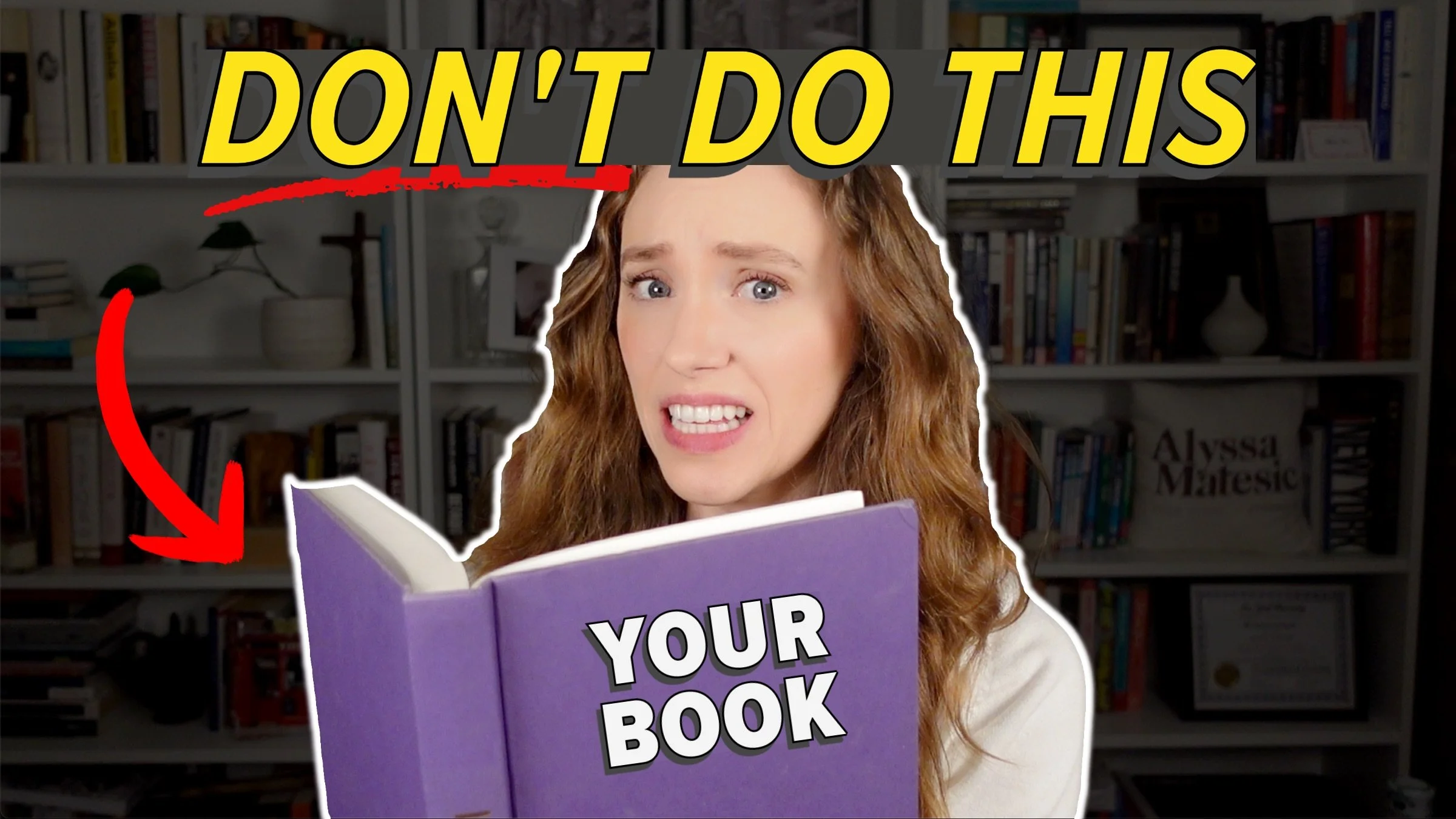8 Cliché Novel Openings to Avoid — and How to Start Your Story Instead
HIT PLAY OR READ THE POST BELOW:
A generic, cliché, or overdone opening scene can sabotage your story before it even begins. As a book editor who previously worked in the publishing industry, I've read hundreds of manuscripts — and today I'm sharing eight lazy openings I see time and time again. If you have one of these scenes, don't worry, because I'll also share exactly how to fix them to create a much stronger start to your story.
Also keep in mind that I'm not saying you can never open with these scenes — you'll see some of them in published books, and they can definitely work in certain cases. But if you have one of them, it's worth considering if that is actually the best entry to your story.
1. On a Plane
This one is my biggest personal pet peeve. If I'm editing a manuscript that starts on a plane, I'll almost always recommend the author changes it.
If you have your main character arriving at a new destination at the start of your story, this might feel like the perfect place to begin. But in reality, putting your character on a plane means locking them in a metal tube where they can't go anywhere or do anything. They can't make meaningful choices. They can't interact with their environment — unless they start up a superficial conversation with the stranger next to them. So they end up just sitting there, reflecting on their life and why they're traveling.
This often leads to a lengthy internal monologue or a backstory dump — which we'll talk more about later. It's a boring start, and the reader is often itchy to see them get to their destination and really start their journey. So begin your story after the travel ends — and the trip really begins.
2. A Dream Sequence
This opening is admittedly really tempting for new writers — but it's also one of the most frustrating ways to start a novel.
You think you're starting with intrigue and mystery, but what you're really doing is tricking the reader. Here's what typically happens: you hook us into a scene where something thrilling or threatening is happening. Maybe something strange or supernatural occurs. Things start to heat up — your character is about to commit a crime, or about to kiss someone, or they're about to die. The stakes feel so high.
Then — surprise! They wake up. It was all a dream. And just like that, you've pulled the rug out from under us. All that tension you built immediately fizzles, because we know that this isn't the character's actual situation and therefore didn’t really matter.
The biggest issue with opening with a dream sequence is that it breaks your trust with your reader. Now you have us wondering what else might be a fake-out deeper in the story. It puts us on edge — and not in a good way.
Typically, what an author is trying to do with a dream sequence is establish the character's inner conflict. But rather than putting this behind the curtain of a dream, instead show that inner conflict play out in a scene where something real is at stake.
You can perhaps move that dream sequence to occur later on in the story — and it may actually be more effective there, once we've already gotten an understanding of the character's inner conflict. Dream sequences can be effective, but only when used sparingly and strategically — and almost never on page one.
3. A Phone Call
This one is especially prominent in mysteries and thrillers. A character will be interrupted, often in the middle of the night, with a phone call that brings bad news — a body has just been found, or their mother is in the hospital. The instinct behind this tactic is good: you want to immediately establish stakes and hook your readers with your opening.
While it is important to establish strong momentum in your opening scene, it's only going to have the intended impact if we understand what the character's life was like before they got that phone call that changed everything. If we don't know what their normal life looks like — or what's at stake for them — then the phone call is not going to mean anything to us.
So instead, show us the character in their element first. Establish their circumstances, even just for a page or two, before that call comes in. That way, we'll understand who they are and what they stand to lose when their life changes forever.
You can still use the phone call as a plot development — just don't open with it totally cold. Give us a reason to care about the character before they get the call.
4. Mid-Conversation
Opening in the middle of a conversation is one of the most disorienting ways to start your novel.
It might seem like a clever way to drop us right into the conflict — a character says something emotionally charged, like "I didn’t kill her," or "Have you seen Anna today?" We can sense the drama, sure, but without more context on who the characters are and what their relationship is, that drama won’t actually land. Again, there are no stakes yet, so the reader isn’t emotionally invested.
When you open your novel mid-dialogue, it feels like we’re eavesdropping — and we’ll only be half-interested in what we’re overhearing. You can certainly have an effective dialogue exchange in your opening scene, but don’t have it as the very first sentence. Start with a line or two of narration to anchor us in the scene and what’s happening, and sprinkle in enough exposition for us to make sense of the conversation as it progresses.
Newer authors often think that they must avoid exposition at all costs — but I promise you, exposition is not the enemy. I have a whole other video that talks about how to write exposition effectively, so I’ll link that in the description for you to check out if you struggle with knowing how much exposition to include.
5. Character’s Life Story
Dumping your character’s entire life story will make your reader immediately put down your book.
It sounds something like this: Alyssa Matessic always loved reading and writing growing up. English was her favorite subject in school. Then she went on to study English and creative writing in New York City. There, she decided she wanted to become a book editor.
Boring, right? We get line after line of background information about the character, but no actual story or scene. We presume this story will be about Alyssa, but we have no sense of what’s going on in the present timeline of the novel — and it sounds more like a Wikipedia entry than a compelling scene.
Remember, readers don’t want to be told the story by the narrator info-dumping. We want to be immersed in the story via scenes. The reader does want to learn about your character’s past — but not all at once, right at the start of the story.
Instead, begin with action. Put your character in an interesting situation, then weave in those backstory details as they become relevant.
6. Moving In or Out
A move feels like a good starting point, but is really just a way of procrastinating kickstarting the plot. We see the character carrying boxes into their new home, reflecting on how they’re about to have a fresh start. Or they’re packing up their final box and saying goodbye.
Like with the plane scene, this transition point might be the first thing that comes to mind when you think about where to begin your story, but the problem is, nothing is actually happening yet. Plus, let’s be real — moving is a long, tedious, often stressful process. Who wants to relive that at the start of your story?
Don’t open with the boring logistics of moving. Instead, open with the first obstacle — big or small — that your character confronts in their new home. Perhaps it is on move-in day, but it’s likely a little bit deeper in the story. Brainstorm what happens to them once the dust has settled.
7. Waking Up
If I had a dollar for every time a manuscript opens with the main character waking up, I could fund an entire writing retreat.
For many writers, when they start their novel, this is immediately where their brain goes. And it makes sense — you want a fresh start, a blank slate. But waking up is not really an interesting event. It’s just a biological function. It’s mundane — and not in a way that makes your character feel relatable, but in a way that makes us wonder what we’re reading for.
Unless something truly extraordinary happens the moment your character’s alarm goes off, starting this way is a missed opportunity. Instead, focus on the moment that your character encounters some kind of tension in their day. Start with the moment the character realizes they’re late for an interview that could change their life — or when they go to start their car and realize it’s not in the driveway.
In almost every single case, opening the novel deeper is much more effective than opening right when they wake up.
8. Unnecessary Prologue
Prologues are one of the most debated topics among the writing community. Let me be clear: I’m not anti-prologue. I’ve seen plenty of brilliant ones. But many of them are not actually necessary and can sabotage the opening of your novel.
The typical bad prologue falls into one of two traps: it’s overly vague and cryptic — and therefore disorienting — or it’s just a massive worldbuilding dump. If you’re using the prologue just to try to create mystery or atmosphere, or you’re trying to unload a lot of exposition on the reader, ask yourself: is it really necessary? Or am I delaying the reader’s arrival at the true start of the story?
Try cutting it entirely and drop the reader in chapter one — and see how it feels. You’ll often find that you didn’t need the prologue after all.
Effective prologues are short, specific, and essential to our understanding of the rest of the story. They either show a key moment that is relevant to the rest of the novel, or flash forward to a pivotal scene that we will get to later. If you have a prologue, make sure it belongs — otherwise, you’re wasting your critical opening pages.
Test It Out
Now that you’re aware of these eight lazy ways to start a novel, you also know how to avoid them. If you’re not sure whether your current opening scene is working the way you intend, here’s a challenge: try cutting that first scene and beginning with the second one. Maybe try cutting the entirety of chapter one and starting with chapter two.
Start deeper in the story and see how it feels — you’ll often find the pacing is so much stronger that way.
Thanks so much for reading, and happy writing!






